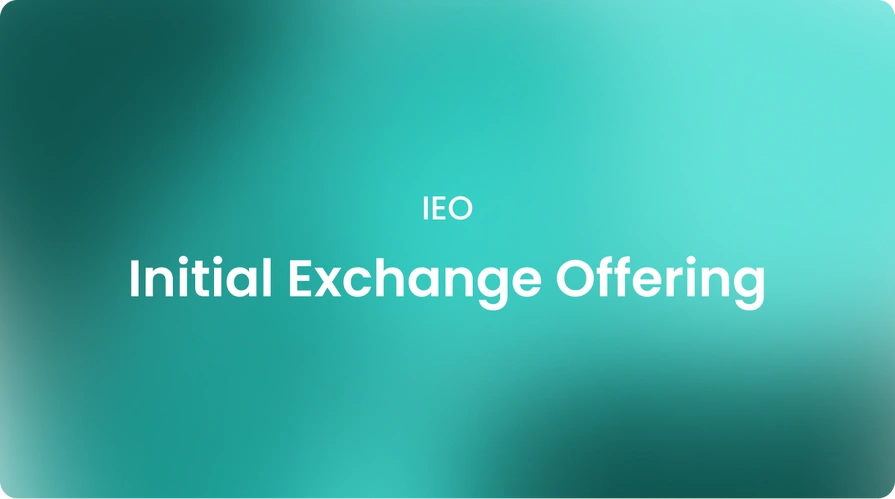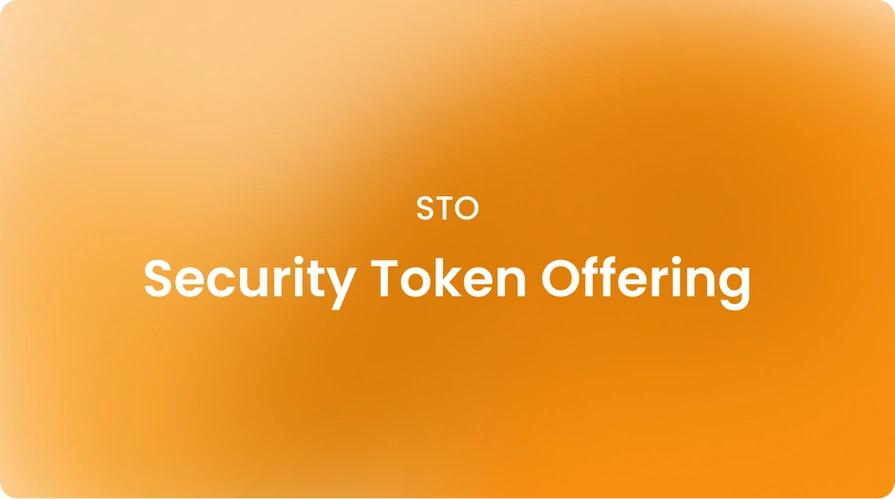|crypto, knowledgehub
What Is an Initial Exchange Offering (IEO)?

Initial exchange offerings (IEO) allow startups to raise funds through cryptocurrency exchanges in a regulated way. In this article, we will explain what an IEO is, how it works, discuss benefits and drawbacks, requirements for launching one, and tips for a successful IEO fundraising event. Let’s start!
How does a crypto IEO work?
An IEO is a crypto fundraising event that takes place through a crypto exchange. Here's a brief overview of the process:
- First, the startup works with the exchange to verify their project and list their token. Exchanges conduct thorough due diligence to avoid fraudulent projects.
- Then, eligible exchange users can purchase the crypto token with cryptocurrency from their exchange crypto wallets during the IEO window, which is typically a few weeks.
- For example, Binance Launchpad has opened a one-hour window for users to participate. Exchanges promote the event, encouraging user participation.
- Once the window closes, the startup successfully raises funds and lists the new token on the exchange. Users can then trade it like any other crypto coin.
How does the verification process for IEOs work?
The verification process for the initial exchange offering ensures projects are legitimate before exposing users to risks. Exchanges assess technical capabilities, financial plans, team backgrounds, legal compliance, and other due diligence factors.
Some checklists include evaluating the quality of the whitepaper, development progress, ecosystem fit, and addressing issues like private key security. Reputable exchanges have rejected over 95% of proposals due to risks.
This safeguards users by only surfacing viable, vetted opportunities. It distinguishes IEOs from ICOs, where anyone could opportunistically launch with minimal oversight. The process provides confidence for participants. Make sure to check out “Initial Coin Offering” to learn more about the ICO process!
What is an example of IEO?
One famous IEO example is BitTorrent (BTT), which launched on Binance Launchpad in January 2019. Within 15 minutes, it raised over $7 million from users of the popular exchange.
The BTT token powers a decentralized streaming platform leveraging the BitTorrent network. Its IEO gave the file sharing protocol access to a huge investor base and helped prove its blockchain plans.
The project met Binance's standards after a thorough review. Its quick funding demonstrated both user appetite and the model's potential to efficiently raise capital for exciting crypto businesses. It highlighted the initial exchange offering concept's advantages over the wild west of ICOs.
The benefits of an IEO
Compared to other crypto fundraising models, IEOs provide benefits to both projects and participants:
- Legitimacy as working with a reputable exchange acts as a seal of approval, increasing confidence.
- The immediate listing of tokens often provides the liquidity that many initial coin offerings (ICOs) lack for months or years.
- On major exchanges, projects gain exposure to a large pre-existing user base.
- Convenience, as users need to only hold the exchange's crypto assets rather than multiple others.
- Security as exchanges handle technicalities like wallets, while projects focus on development.
- Marketing as exchanges promote IEOs, increasing visibility far beyond a project's own efforts.
The Drawbacks of IEO
While IEO addresses many ICO issues, they are not without challenges.
- Exchanges charge hefty listing fees, ranging from $100K to millions for top spots. This cost burdens small startups.
- Centralization as projects rely on exchanges, ceding some control over distribution compared to public blockchain launches.
- Bias, as exchanges prioritize their financial interests, could sway the assessment and promotion of some projects.
- Volatility as the performance of post-IEO tokens will have a direct impact on the exchange, adding price manipulation incentives.
- Red tape, as exchanges have lengthy application processes, may cause delays in fundraising timelines.
So initial exchange offerings trade some decentralization and self-sovereignty for stronger oversight and marketing reach.
Launching an IEO
For startups ready to undertake an IEO in crypto, here are the core steps:
- Develop an MVP and a detailed white paper outlining the vision, tech, tokens, team, and market opportunity.
- Select an exchange based on alignment with the project type and the size of their user base.
- Meet listing requirements, such as the application form, legal documents, review fees, and any minimum crypto fundraising targets.
- To create hype and participation, market the pre-sale and IEO launch among relevant communities.
- Set hard caps on token sales to reduce volatility and maintain post-IEO stability.
- Work with the exchange's technical team through the listing process and subsequent trading period.
- Draw up a roadmap for delivering on promises to build long-term trust after crypto fundraising ends.
- With dedication at each stage, projects can tap into an exchange's deep liquidity and visibility to achieve their funding needs.
The requirements for IEO white papers
A professional white paper is key to passing an exchange's evaluation. At minimum, it should clearly explain:
- The solution will address the issue or pain point within the industry.
- How the solution operates at its core and provides value
- The technical architecture provides a breakdown of the token utility.
- Development status and future roadmap.
- The token distribution timeline and the unlock schedule are available.
- Discussion of the fundraising objectives and the distribution of funds.
- The team's biographies serve as evidence of their qualifications.
- Legal structure and compliance with regulations.
- Potential risks and mitigation strategies.
By addressing all crucial details, the white paper demonstrates forethought and justifies seeking exchange support and investments for IEO.
Other ways of exchange-administered fundraising
While IEOs gained popularity in 2019–20, exchanges experimented with variations like:
ICO
ICO, or initial coin offering, is a method for cryptocurrency projects to raise funds by offering a new token in exchange for established cryptocurrencies. Despite their popularity during the 2017 cryptocurrency boom, ICOs face scrutiny due to fraud and regulatory issues.
STO
STO, or security token offering, is a fundraising method similar to an ICO but backed by real assets or ownership stakes. STOs involve more legal compliance and offer investors a more regulated, potentially safer investment option. The compliant token offering structure is regulated as securities with KYC/AML.
IDO
IDO is a fundraising method on decentralized exchanges (DEXs), allowing anyone with access to the exchange to participate in the sale of tokens. It is often associated with decentralized finance projects.
Each model brings exchanges deeper into the crypto fundraising process, providing alternatives for different project types and risk appetites. In essence, ICOs launch new cryptocurrencies, STOs use asset-backed tokens, and IDOs are decentralized exchanges for accessible fundraising.
The trend reflects a growing symbiosis between exchanges and the crypto economy. These alternatives present newer opportunities for both investors and startups, positioning exchanges as all-around blockchain solution providers, such as Cryptobunq.
Cryptobunq is a one-stop-shop crypto service provider that you can trust for your crypto and blockchain projects. CBQ offers expert solutions for individuals and businesses.
From custody and wallet to crypto exchange API, from crypto checkout and invoicing to crypto batch payments, from tokenization to node as a service, CBQ is a one-stop shop for all your crypto needs.
If you want to learn more about our solutions and see our expertise in the field of Web3, make sure to check out our case studies!
What is the difference between an ICO and an IEO?
The main differences between initial coin offerings and initial exchange offerings are:
Regulation
IEOs involve exchanges conducting KYC/AML checks and due diligence for compliance. ICOs were historically unregulated wild west environments.
Access
Initial coin offerings allow anyone globally to participate. IEOs are only open to verified exchange users, giving them a smaller but wider audience.
Marketing
Exchanges powerfully promote IEOs, while ICOs relied on projects' own efforts, which were usually far more limited.
Liquidity
Initial exchange offering tokens could be traded immediately if listed, unlike ICOs, where it often took a long time for listings and trading to begin.
Risk
ICO scams and hacks were common due to a lack of oversight, whereas IEOs provide more assurance through the exchange's review processes.
So IEOs addressed many ICO criticisms, like securities issues, by centrally managing compliant token sales. However, the final choice is up to you and your project’s requirements.
Tips for a successful fundraising event
- Follow all exchange guidelines meticulously and submit your highest-quality work.
- Crowdfund via social media engagement for weeks prior, using your one-pager and teaser video.
- Publish regular updates to build trust during your listing period via the exchange blog.
- Work with service providers to plug any expertise gaps in legal, accounting, and marketing.
- Set a reasonable yet exciting crypto fundraising goal that leaves upside for future expansion.
- Have a multi-stage plan to keep momentum going post-IEO, with frequent deliverables.
- Express deep gratitude to the exchange, its users, and its backers to cement goodwill.
- Leverage the services of Cryptobunq for maximum security.
With preparation, professionalism, and follow-through, your project can maximize its funding potential through the initial exchange offering avenue.
The bottom line
Initial exchange offerings provide a regulated pathway for startups to access global liquidity and present viable products to new user communities.
With appropriate management of expectations and relationships on all sides, the IEO model will likely continue its momentum in enabling true blockchain innovation.
By partnering with reputed platforms like Cryptobunq, which offers various crypto services, projects have reliable venues to establish themselves while participants gain exposure to hand-picked opportunities. Contact us today and grow your projects with the power of blockchain technology!













